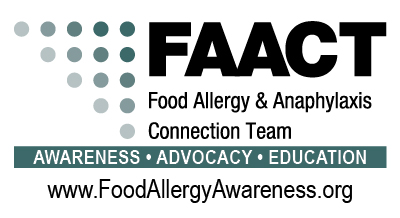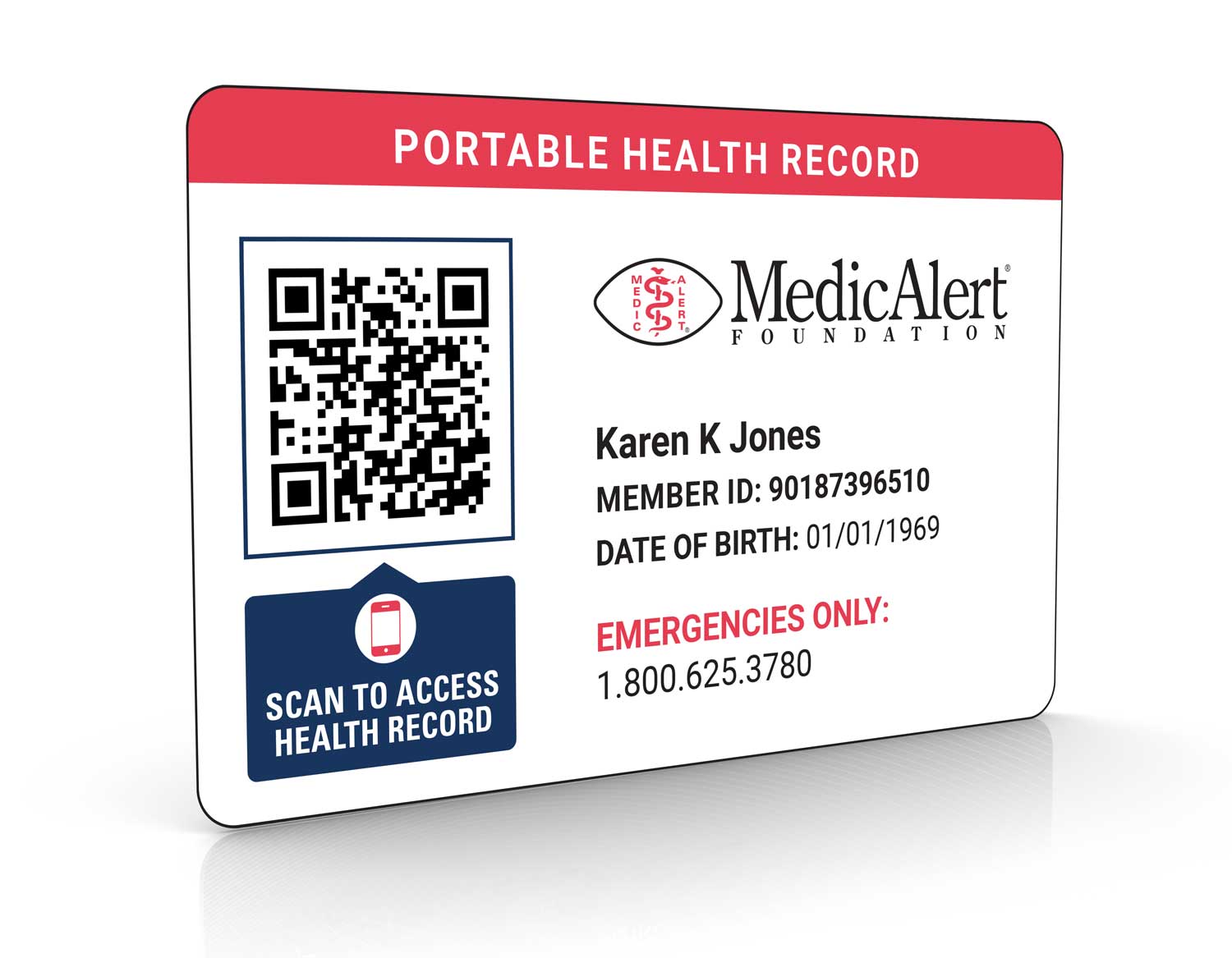Help others help you. Wear a medical alert ID bracelet or necklace engraved with important information for emergency responders and healthcare providers
Centers for Disease Control & Prevention

Medical IDs for Food Allergy
The confidence to live with food allergy
Foods and substances that can cause an allergic reaction can be found in the things we use and consume every day. This includes processed food products, beverages, medications, cosmetics, and more. In some cases, food allergy can cause a mild reaction. In others, reactions can be dangerous—even fatal. To help avoid a reaction, people living with food allergies are usually vigilant about reading labels. Knowing what’s in edible products and others can help prevent a reaction. However, if someone living with food allergy is in an accident or other emergency, they could become unresponsive, making it impossible to communicate their condition to first responders.
This is just one reason why people living with this condition should wear MedicAlert medical IDs for food allergy.
How MedicAlert protects those living with food allergy
One thing you shouldn’t worry about is what could happen if there’s an emergency. MedicAlert’s protection plans offer benefits that extend beyond the ID, providing safety and peace of mind for people living with food allergy, their families and caregivers.

24/7 Emergency Response
Our team provides first responders the information they need to provide fast, accurate care.

Digital Health Profile
All your vital information, all in one place for you and your caregiver.

Emergency Contact Notification
In an emergency, we connect families so that no one is alone in a crisis.

Patient Instructions
Share the information that’s important to your care, such as use of rescue medications or contraindication for tests like MRIs.
Pair a medical ID for food allergy with the protection plan that’s right for you.
What is food allergy?
The Food Allergy & Anaphylaxis Connection Team (FAACT) reports that food allergies affect as many as 32 million Americans, including six million children. Studies estimate that up to 1 in 10 adults in the U.S. and 1 in 13 children have a food allergy. This is an average of two children per classroom. Food allergy is a common medical condition that can cause medical emergencies without warning. This is why it’s so important for those living with the condition to wear medical IDs for food allergy.
The Asthma and Allergy Foundation of America (AAFA) says food allergy occurs when the body’s immune system sees a certain food as harmful and reacts by causing allergic symptoms. Foods that cause allergic reactions are allergens. Not to be confused with food intolerance, a less serious condition that involves the digestive system—not the immune system, food allergy can affect many different areas of the body at the same time. Food allergy is more severe, and it can even be life-threatening, causing a host of symptoms from hives and swelling of the face to anaphylaxis (narrowing of the airways, blocking breathing). Anaphylaxis is dangerous and requires immediate medical treatment.
More than 170 foods have been reported to cause allergic reactions, but just eight account for 90% of food allergies. In 2004, Congress passed the Food Allergen Labeling and Consumer Protection Act (FALCPA), which identified these eight major food allergens. The Food Allergy Safety, Treatment, Education and Research (FASTER) Act of 2021 expanded this list, among other things. The original eight major food allergens include:
- Eggs (typically from chickens, but also ducks, geese, quail, and other birds)
- Fish (bass, flounder, cod)
- Milk (one of the most common food allergies in children, primarily cow’s milk, but also sheep, goat, and buffalo milk)
- Peanuts (legume in the same family as peas and lentils)
- Shellfish (shrimp, crab, lobster)
- Soybeans (edamame, miso, soy, tofu, also found in canned broth, soup, baked goods)
- Tree nuts (top six responsible for allergic reactions in children and adults: walnuts, almonds, hazelnuts, pecans, cashews, pistachios)
- Wheat (bread, flour, noodles, pasta, bran, couscous)
Beginning January 1, 2023, sesame will officially become a part of this list, bringing the number of major food allergens to nine. Sesame refers to any type of sesame and in any form including seeds, oil, powder, paste, etc.
What causes food allergy?
When a person has food allergy, the body’s immune system mistakenly identifies a harmless food or substances in foods as a threat. Researchers at Mayo Clinic say when this happens, the immune system triggers cells to release an antibody known as immunoglobulin E (IgE) to neutralize the allergy-causing food or food substance. The next time the individual eats even the tiniest amount of that food, IgE antibodies sense it and signal the immune system to release a chemical called histamine, as well as other chemicals, into the bloodstream. These chemicals cause allergy symptoms (a reaction).
Reactions can be mild to severe and may include everything from an itchy mouth or hives to wheezing, and even anaphylaxis.
According to the National Institutes of Health (NIH)-National Institute of Allergy and Infectious Diseases (NIAID), researchers have discovered several factors that can increase a person’s risk for developing food allergy. The condition is most likely to affect people who already have another allergic disease, or individuals who come from a family in which allergic diseases such as food allergies, eczema, hay fever, or asthma are common. It is also believed that individuals who already have food allergy are prone to developing additional food allergies.
Researchers at Mayo Clinic say eating certain foods may cause some people to feel itchy and lightheaded soon after starting to exercise. This is known as exercise-induced food allergy. Serious cases of exercise-induced food allergy can cause everything from hives to anaphylaxis.
What to engrave on MedicAlert medical IDs for food allergy:
MedicAlert offers free custom engraving on all our food allergy bracelets and medical ID products. Engravings on medical IDs for food allergy should include any critical medical information that can protect and save lives in an accident or medical emergency, for example:
- Food allergy or severe food allergy
- Medications
- Auto-injectable device (EpiPen)
- Designated physician and emergency contact information

Sample engraving. Consult our team if you need help engraving your medical ID for food allergy.
What are the symptoms and complications of food allergy?
Food allergy symptoms can develop within a few minutes to two hours after eating an offending food. In rare cases, it can take several hours for symptoms to develop. For some people living with food allergy, reactions can be mild. In others, reactions can be severe to life-threatening.
The most common food allergy symptoms include:
- Abdominal pain, diarrhea, nausea or vomiting
- Dizziness, lightheadedness, or fainting
- Hives, itching, or eczema
- Swelling of the lips, face, tongue, and throat or other parts of the body
- Tingling or itching in the mouth
- Wheezing, nasal congestion, or trouble breathing
The most life-threatening food allergy reaction is anaphylaxis. Symptoms of anaphylaxis include:
- Constriction and tightening of the airways
- Dizziness, lightheadedness, or loss of consciousness
- Rapid pulse
- Shock with a severe drop in blood pressure
- Swollen throat or the sensation of a lump in your throat that makes it difficult to breathe
Anaphylaxis requires immediate medical attention. If left untreated, anaphylaxis can cause a coma or even death.
How do you diagnose food allergy?
There is no one test to diagnose food allergy. To help diagnose the condition, your doctor will use a variety of methods and tools. Your doctor will likely begin by assessing your symptoms and family history, performing a physical exam, and ordering skin and blood tests. According to Kids With Food Allergies (KFA), a skin test or skin prick test (SPT) involves placing a drop of allergen onto the surface of the skin, and then pricking through it to introduce the allergen into the top layer of the skin. A blood test can measure the immune systems response to suspected foods by measuring IgE.
Your doctor may also suggest an elimination diet, which involves eliminating suspected foods for a week or two, then adding them back into the diet one by one. This will determine if you have a true food allergy or a food sensitivity.
An oral food challenge may also be performed to confirm if a food does or does not cause an allergic reaction. During an oral food challenge (done in your doctor’s office), you will eat the suspected food to determine if it is causing your symptoms.

We are proud to partner with the Food Allergy & Anaphylaxis Connection Team (FAACT), the leading patient organization for people with food allergies.
How do you treat, manage, and live with food allergy?
If you are living with food allergy, one of the best ways to avoid a reaction is to avoid the offending food. However, this is easier said than done as certain trigger foods or substances can be hidden in something that you might eat or drink, breathe in, or use on the skin. It is also impossible to know all of the ingredients in foods while dining out.
If you have mild reactions to certain foods, carrying an antihistamine can help. Offered over-the-counter (OTC), an antihistamine can be taken after exposure to an allergen to help relieve symptoms such as hives and itching. Diphenhydramine (Benadryl) is one of the most common antihistamines for food allergy. For severe reactions, you might have to carry an epinephrine autoinjector (EpiPen). This device contains a single dose of medication that can be injected into the thigh. An EpiPen is commonly used for anaphylaxis.
How medical IDs for food allergy combined with MedicAlert Membership provide peace of mind
A MedicAlert food allergy bracelet can protect you when you are unable to protect yourself. If you are in an accident or have another medical emergency, medical IDs for food allergy can alert first responders, ER doctors, and emergency room staff that certain foods, medications, and other substances must be avoided. Food allergy can also be mistaken for other conditions such as food poisoning, celiac disease, and enzyme insufficiency. A medical ID for food allergy can help first responders quickly identify your condition, which can help avoid a misdiagnosis, ensuring the fastest, safest, and most appropriate treatment.
Add a MedicAlert protection plan, and you will have an additional layer of protection in medical emergencies and other health-related situations.
If you are living with food allergy, a MedicAlert protection plan can help ensure fast and accurate care by delivering detailed information about your condition to emergency responders and ER doctors. This will help ensure that your healthcare team knows that you are living with food allergy so certain foods, substances, and medications can be avoided. This will ensure that the safest and most appropriate treatments are administered.
- We’re your voice: If you can’t speak for yourself due to a medical emergency, your ID will speak for you – informing others about your food allergy and any medications you’re taking.
- 24/7 emergency protection: In an emergency, the MedicAlert team will relay all of your critical medical information to first responders, no matter where or when your emergency happens.
- Always connected: You should never be alone in an emergency. That’s why MedicAlert will reach out to your designated contacts if you are unable to do so.
- Live with peace of mind and confidence: MedicAlert will be there for you every step of the way. You’ll have the confidence and freedom to live your life with food allergy, knowing we’ve got you covered.
Sources: Asthma and Allergy Foundation of America (AAFA); Food Allergy & Anaphylaxis Connection Team (FAACT); Food Allergy Research & Education (FARE); Kids With Food Allergies (KFA)-A Division of the AAFA; Mayo Clinic; National Health System (NHS); National Institutes of Health (NIH)-National Institute of Allergy and Infectious Disease (NIAID); U.S. Food and Drug Administration (FDA)
DISCLAIMER: THIS WEBSITE DOES NOT PROVIDE MEDICAL ADVICE. The information in this article is presented for educational purposes only and is not intended as a substitute for professional medical advice, diagnosis and treatment. Always seek the advice of a physician or other qualified healthcare provider for any questions you may have regarding a medical condition or treatment.







